The crypto market is currently experiencing the early stages of a transition from Bitcoin dominance to altcoins within a bull market cycle.
1. Introduction
On July 14, Bitcoin's price broke through $120,000, reaching a historic high, while altcoins also welcomed a long-awaited wave of broad gains. This rapid market change has sparked heated discussions among investors about whether the "altcoin season" has truly begun. With rising expectations for Federal Reserve rate cuts, a shift towards easing macro policies, and continuous institutional capital flowing into Bitcoin and Ethereum, the market's risk appetite has significantly increased. However, Bitcoin's dominance remains high, the ETH/BTC ratio has not broken through key resistance, and capital flows exhibit selective dispersion characteristics. Is the current rise of altcoins a genuine signal for the start of an "altcoin season", or is it merely a short-term frenzy driven by capital?
This article will provide a comprehensive in-depth analysis from multiple dimensions, including macro background and institutional capital layout, fund flows and index analysis, on-chain activity and ecological recovery, market sentiment, and heat changes, helping investors clarify the current complex market situation through rigorous data interpretation, and review and analyze popular and potential tracks, hoping to assist investors in discerning essence and seizing opportunities and risks in a chaotic and complex market environment.
2. Macro-level Analysis
1. Macroeconomic Environment Tending Towards Easing
Recently, the global macro environment has continued to tilt towards easing, with favorable factors continuously emerging. Firstly, the Federal Reserve's monetary policy has shifted to a milder stance: the minutes from the July meeting indicated increasing division between hawks and doves within the Fed, with Waller proposing a rate cut in July and Bowman supporting an earlier cut, but most officials still prefer to maintain a wait-and-see approach. Federal funds futures show a 65% probability of a rate cut in September, significantly raised from previous expectations, while the Fed's own economic forecasts also show an unusual hawk-dove standoff: 12 officials support a cumulative 50 basis point cut by 2025, while 7 support a 100 basis point cut. On one hand, the easing capital environment has driven up the valuations of Bitcoin and crypto assets; on the other hand, persistently high interest rates have made the market more sensitive to rate cut timings, and once the central bank announces dovish signals, Bitcoin's upward momentum may sharply amplify.
Recently, the easing of global trade frictions has also provided a relatively friendly macro background for the crypto market. Additionally, geopolitical risks have eased somewhat, and the market's sensitivity to geopolitical risks is decreasing. The recent U.S. regulatory environment has also shown supportive signals: changes in SEC leadership, the promotion of the stablecoin bill (GENIUS Act), the establishment of Bitcoin strategic reserves, and the White House releasing a digital asset policy blueprint have all reduced regulatory uncertainty and boosted investor confidence.
2. Institutional Capital Continues to Flood In
Institutional capital continuing to flood in is an important driver for market prosperity. Overall, institutional investment is gradually expanding from focusing on Bitcoin and Ethereum to other public chain asset areas. On July 16, Bitcoin spot ETF saw a net inflow of $799.5 million, with assets totaling $148.84 billion, marking the tenth consecutive day of net inflows; Ethereum spot ETF saw a net inflow of $716.63 million, with assets totaling $13.25 billion, marking the ninth consecutive day of net inflows. Although Ethereum's spot price increase has lagged behind Bitcoin's since 2025, institutional funds are accelerating their entry through ETFs. With ETH returning above $3000, the accumulation effect of ETFs is becoming more apparent, which in turn boosts the popularity of the Ethereum and altcoin markets.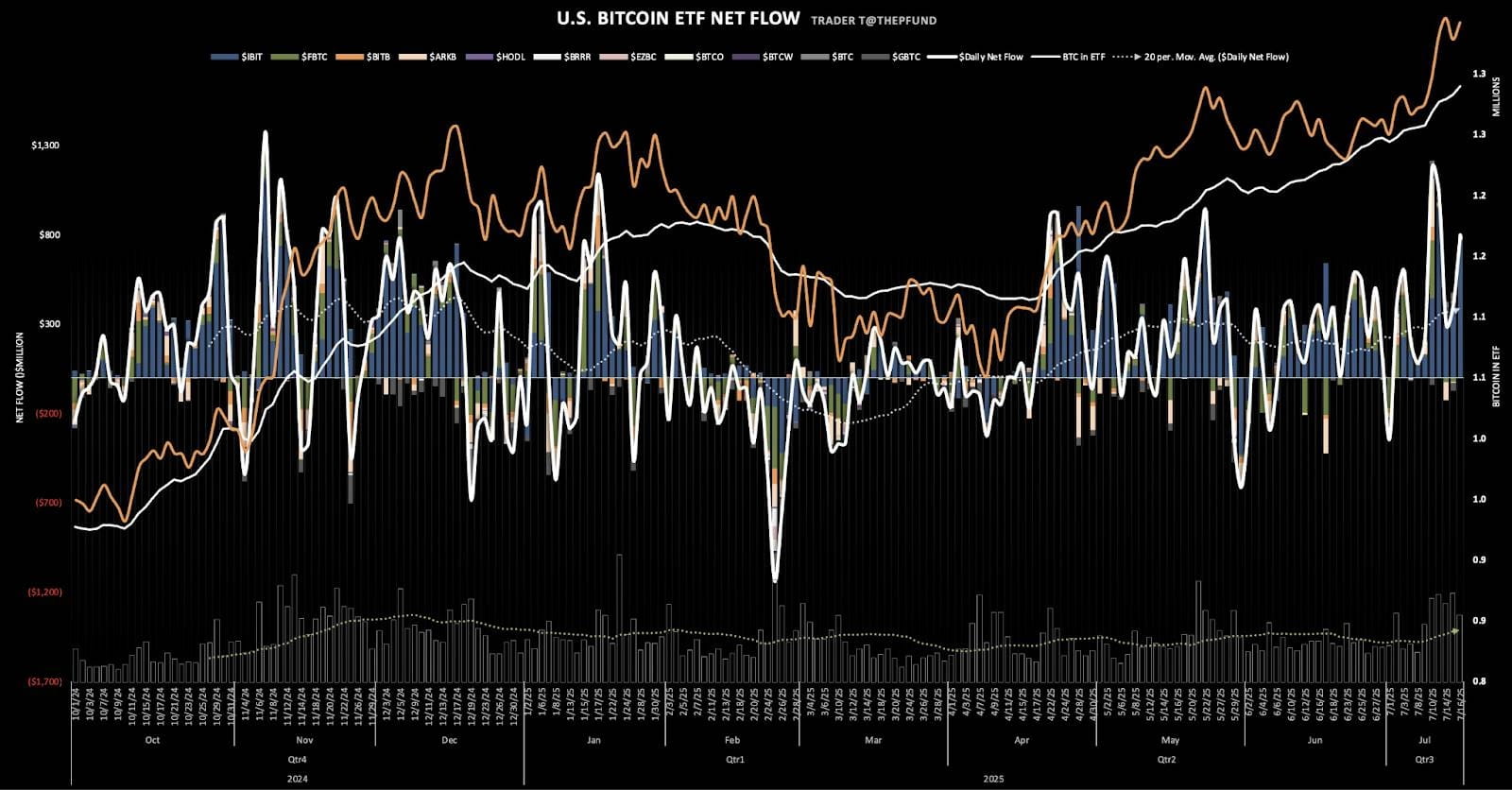
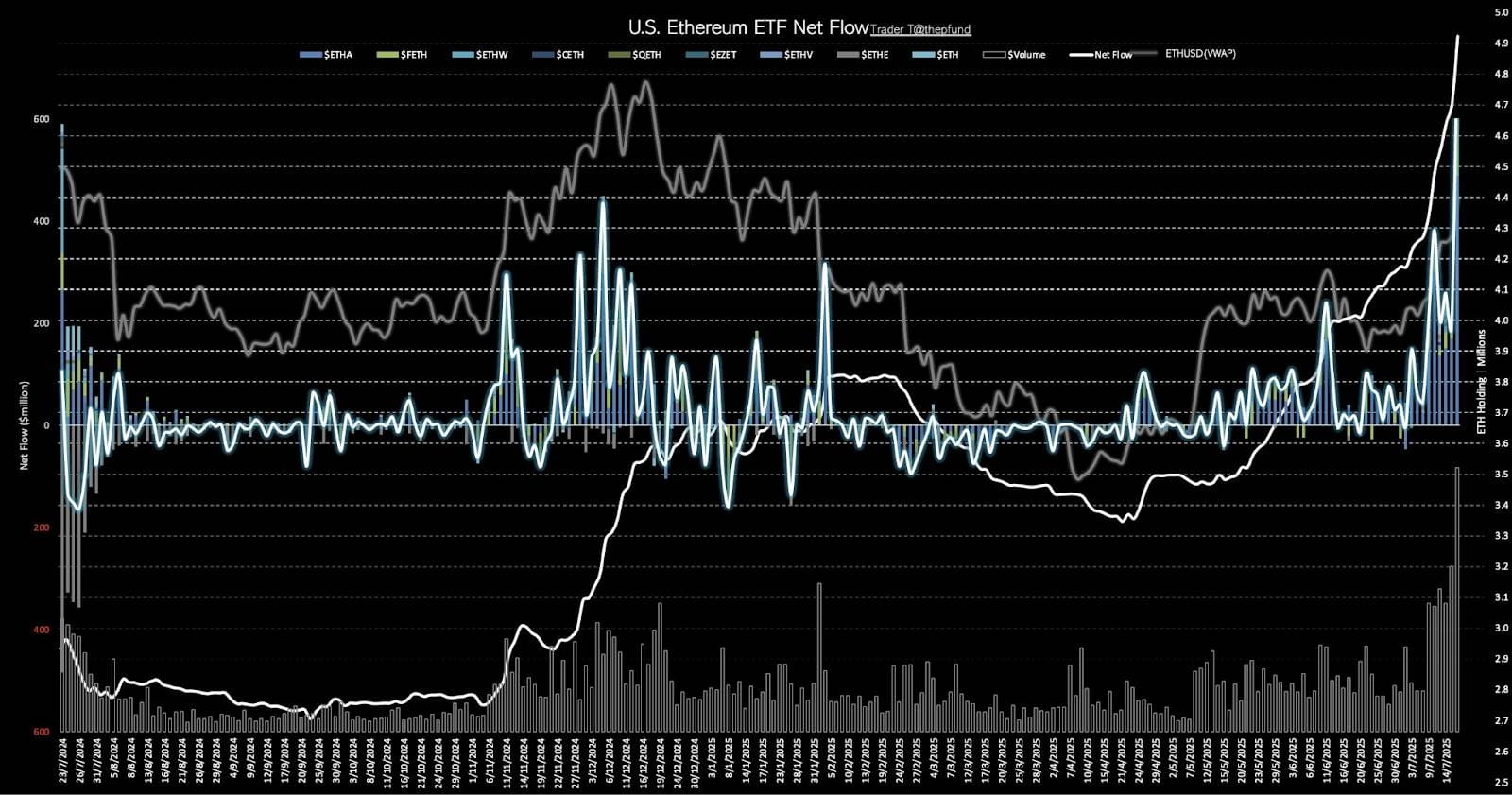
In addition to BTC and ETH, institutional capital is also gradually positioning itself in blockchain tracks outside of Ethereum. Currently, companies like VanEck and Bitwise have submitted applications to the SEC for Solana spot ETFs. Grayscale, the largest crypto asset manager, has established trust products that include a basket of altcoins. On July 15, U.S. asset management company ProShares launched 2x long Solana futures ETF (ticker: SLON) and 2x long XRP futures ETF (UXRP), which were officially listed on NYSE Arca. This reflects that mainstream altcoins are gaining more attention and allocation from mainstream investors.
Some listed companies have begun to incorporate crypto assets outside of Bitcoin into their balance sheets. On July 15, SharpLink Gaming (NASDAQ: SBET) held 296,508 Ethereum, valued at approximately $999 million, surpassing the Ethereum Foundation to become the largest holder of ETH globally, dubbed the "MicroStrategy of Ethereum." The number of institutions holding over 100,000 ETH has increased to seven, including: SharpLink Gaming (280,600 ETH), Ethereum Foundation (241,500 ETH), PulseChain Sac (166,300 ETH), Bitmine Immersion (163,100 ETH), Coinbase (137,300 ETH), Golem Foundation (101,200 ETH), and Bit Digital (100,600 ETH).
Furthermore, the "SOL version of MicroStrategy" DeFi Development Corp has accumulated 640,585 SOL and its equivalent assets, totaling a value of $98.1 million. Starting from July 17, SRM Entertainment officially changed its name to Tron Inc, changing its stock code from "SRM" to "TRON". Tron previously announced it would achieve listing through a reverse merger and initiate a TRX strategic reserve, with SRM having staked all its TRX to earn staking rewards.
3. Fund Flows and Index Analysis
1. Bitcoin Dominance
Bitcoin Dominance (BTC Dominance) measures the ratio of Bitcoin's market capitalization to the total market capitalization of all cryptocurrencies. A peak and subsequent decline in Bitcoin's share is one of the typical signals for the onset of an "altcoin season." On July 14, Bitcoin's price broke through $120,000, yet Bitcoin's dominance (BTC Dominance) showed a downward trend, currently at 62.88%, but still at a historically high level. The sustained high level of Bitcoin dominance indicates that Bitcoin has absorbed a significant amount of new capital, while altcoins have not yet received widespread enthusiasm. Only when this ratio significantly declines and capital moves from Bitcoin to smaller assets can clear signs of an altcoin season emerge.
 2. ETH/BTC Ratio
2. ETH/BTC Ratio
The ETH/BTC ratio reflects Ethereum's relative performance against Bitcoin and is seen as a leading indicator of capital flow into altcoins. An increase in the ETH/BTC ratio often suggests that capital inflows into altcoins may be starting. If this ratio continues to rise, it indicates more capital moving from Bitcoin to Ethereum and other altcoins, which will provide strong support for an altcoin bull market. Currently, the ETH/BTC ratio is on an upward trend, indicating that capital inflows into Ethereum are accelerating. The ETH/BTC ratio has rebounded from a low of 0.017 in Q1 to 0.029. Technically, some analysts suggest that if the ETH/BTC ratio can effectively break through 0.03, it would signify a shift in market risk appetite from Bitcoin to Ethereum and altcoins, potentially triggering a new round of altcoin momentum and fully reviving the altcoin market.
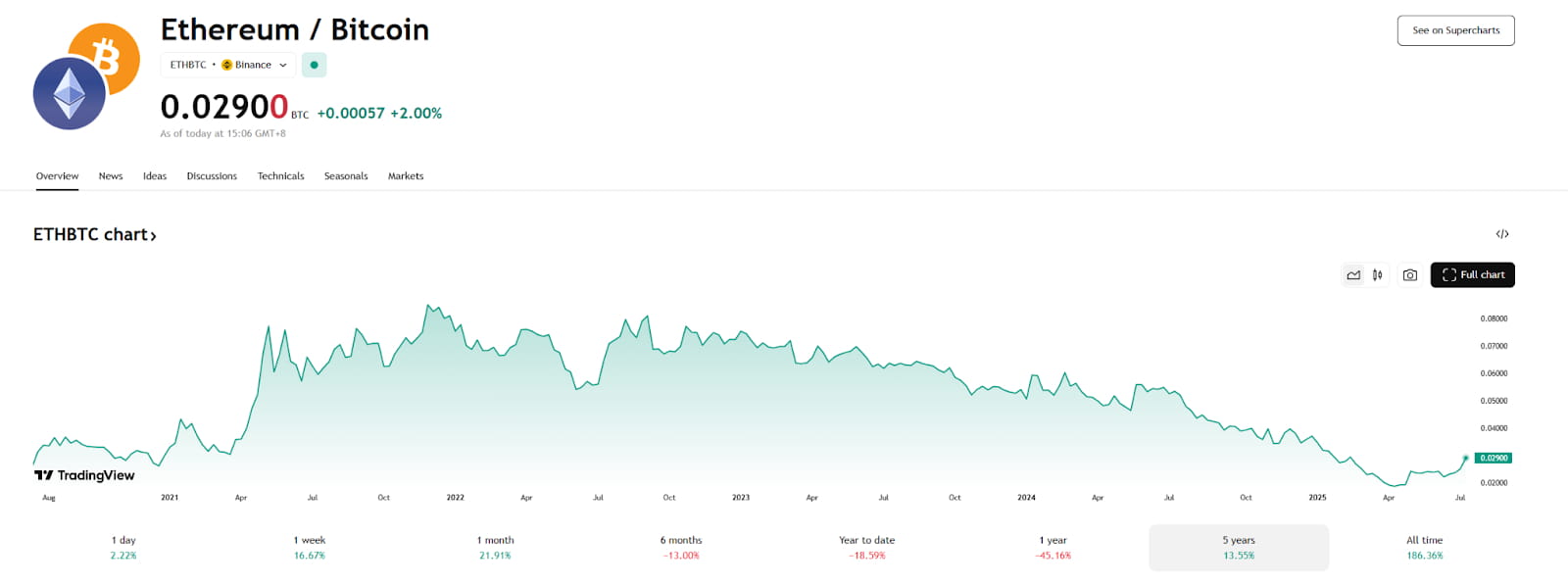 3. Altcoin Season Index
3. Altcoin Season Index
The Altcoin Season Index (Altcoin Season Index) is used to measure whether non-Bitcoin assets (altcoins) have collectively outperformed Bitcoin over the past 90 days. According to CoinMarketCap's algorithm, when at least 75% of the top 100 cryptocurrencies (excluding stablecoins) outperform Bitcoin, it is deemed an altcoin season; if only 25% or fewer altcoins outperform Bitcoin, it is considered a Bitcoin season. The altcoin season index has recently warmed up again: it had once dropped to around 15 in mid-June, but began to rebound rapidly starting in July, reaching 39 this week. This index is based on the number of altcoins outperforming Bitcoin over the past 90 days, currently indicating that about four out of ten mainstream coins are outperforming BTC, suggesting that the performance of altcoins in the current market is becoming more active.
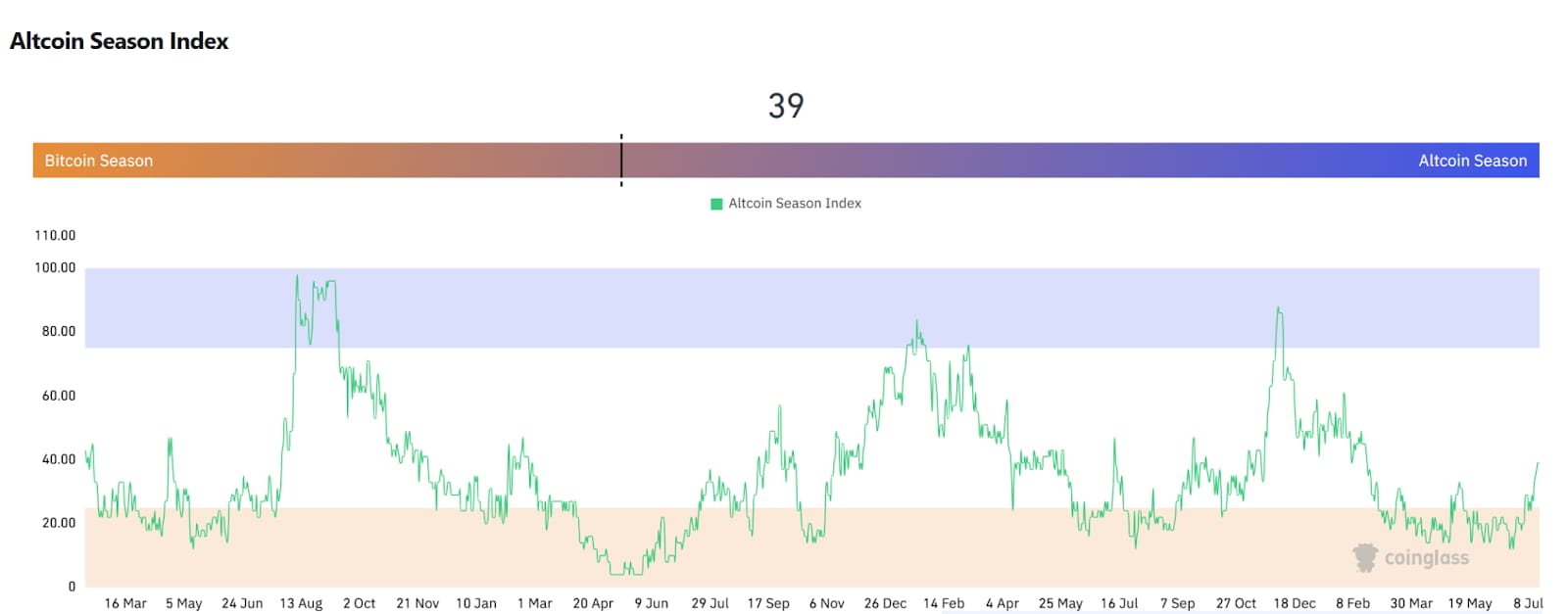 4. Market Share and Trading Volume of Altcoins
4. Market Share and Trading Volume of Altcoins
According to CoinGecko data, the current overall crypto market's 24-hour trading volume is about $243.7 billion, with Bitcoin trading volume accounting for about 21%, Ethereum trading volume accounting for about 17.5%, and other tokens accounting for about 61.5%, with the trading volume ratio significantly climbing. This is mainly because, with Ethereum's significant rebound, mainstream altcoins have been at low levels after continuous declines, combined with rising narratives, suggesting signs of "bottom-fishing" in the market. It is important to note that while the relative trading volume of altcoins has increased, it is not a comprehensive rise but rather a selective rotation of capital among hot themes, with current capital flows showing a characteristic of "actively seeking the next theme and blue-chip" rather than a "full embrace of all altcoins."
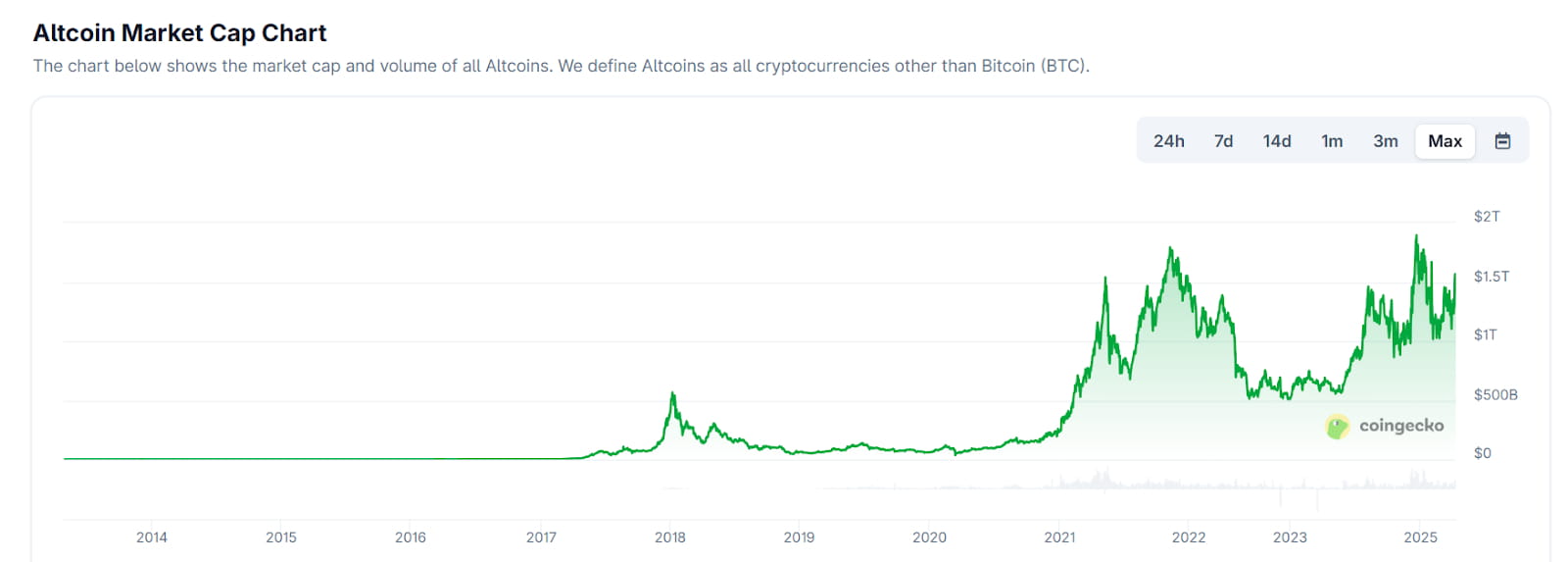 4. On-chain Activity and Ecological Recovery
4. On-chain Activity and Ecological Recovery
1. On-chain Activity
On-chain activity indicators (such as daily active addresses, daily transaction counts, etc.) reflect network usage and user engagement. Data indicates that on-chain activity has significantly warmed recently. Ethereum regained the top spot for Gas fee revenue in June, while Solana continues to lead in activity rankings, with over 29.7 billion transactions (approximately 4.8 million daily active addresses) in June alone, far exceeding Ethereum and Bitcoin.
As of July 17, 2025, the number of daily active ERC-20 addresses on Ethereum is approximately 510,000, a year-on-year increase of about 50.8%. This significant growth reflects that more users and applications are using the Ethereum network. On the other hand, the DApp ecosystem is also showing activity, with the daily average active wallet count (dUAW) rising to 25 million, an 8% month-on-month increase. DeFi TVL and NFT transaction volumes have surged by 25% and 40% respectively, further indicating an overall increase in on-chain user activity. These data suggest that both capital and user participation are heating up, providing a foundational environment for the rotation of the altcoin market.
2. DeFi's Asset Lock-up TVL
The TVL of DeFi has rebounded, with Ethereum surging 40%, driving many protocols' TVL to soar, with leading protocols like Aave seeing a month-on-month increase of about 20%; Lido, EigenLayer, and others have shown volatility, but overall locked funds remain substantial. In the Layer-2 space, Base has rapidly risen, with a cumulative transaction volume of 292 million in June and an average of about 1.71 million daily active addresses. Arbitrum (ARB) and Optimism (OP), as leaders in Ethereum Layer-2, also continue to maintain recent narrative heat. Although ARB has not yet approached its high from last year, it has received funding support for re-empowering DeFi applications. Chainlink (LINK) has benefited from the recovery in oracle demand and maintains a dominant position in the data market. The Aptos (APT) community has seen significant growth in activity, with prices rising to about $5.9, indicating that the DeFi ecosystem is regaining vitality and attracting funds back.
As of July 17, the total value locked (TVL) in the DeFi market increased from $89 billion at the beginning of the year to approximately $132 billion in June, particularly as innovative projects and new financial protocols garnered significant funding. 5. Market Sentiment and Heat Indicators
5. Market Sentiment and Heat Indicators
Market sentiment often signals the rotation of capital in and out. The Fear & Greed Index is a commonly used indicator for measuring overall market sentiment. As of mid-July, market sentiment is notably optimistic, with investors' FOMO emotions accumulating. Since July, the Fear & Greed Index (Crypto Fear & Greed) has remained high, continuously climbing above 70 into the "Greed" level.
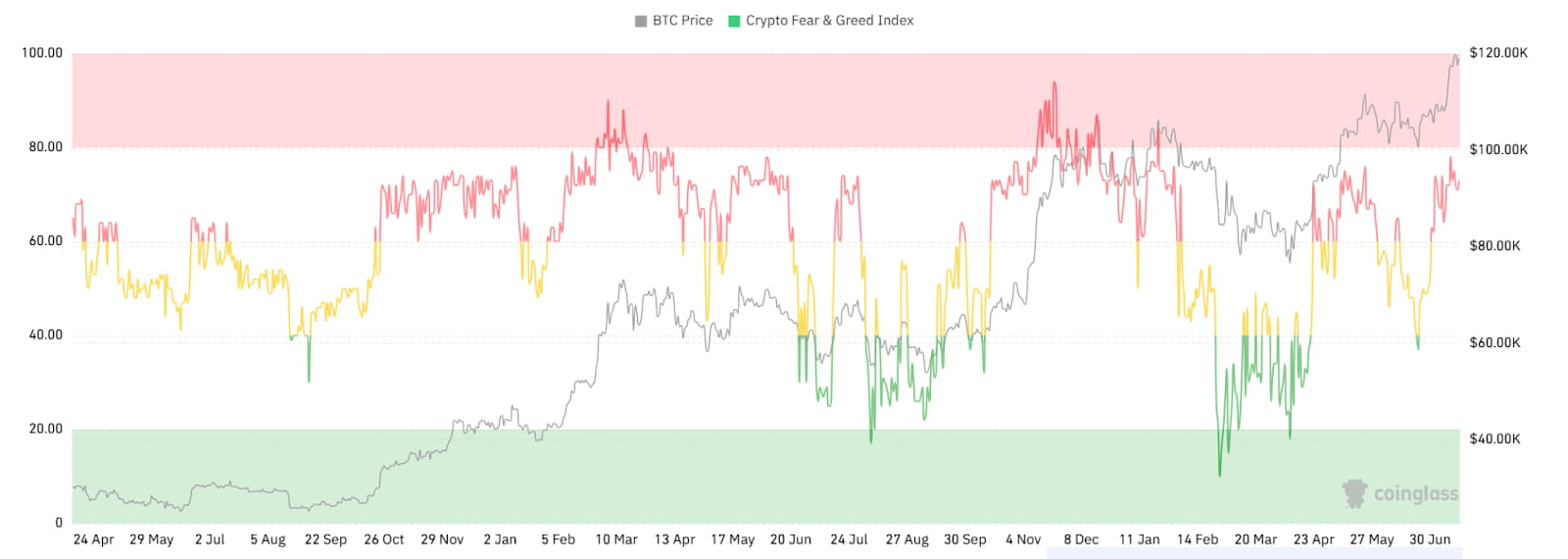 Compared to the price surge, public attention has not yet significantly increased. Google Trends shows that while Bitcoin's current price has reached a new high, its search popularity is far below the peaks of the bull markets in 2017 and 2021. This indicates that although large amounts of capital are flooding in, the enthusiasm from retail investors and the general public is still in the nurturing stage. Discussions about altcoins on social platforms like X are also relatively flat, lacking explosive topics. Overall, the market displays a clear FOMO atmosphere while also harboring a degree of cautious sentiment. Although Google Trends indicates that the interest in Bitcoin keywords has not reached previous peaks, there has been an increase in altcoin-related search volumes, suggesting that retail investors' focus is partially shifting from Bitcoin to more altcoins.
Compared to the price surge, public attention has not yet significantly increased. Google Trends shows that while Bitcoin's current price has reached a new high, its search popularity is far below the peaks of the bull markets in 2017 and 2021. This indicates that although large amounts of capital are flooding in, the enthusiasm from retail investors and the general public is still in the nurturing stage. Discussions about altcoins on social platforms like X are also relatively flat, lacking explosive topics. Overall, the market displays a clear FOMO atmosphere while also harboring a degree of cautious sentiment. Although Google Trends indicates that the interest in Bitcoin keywords has not reached previous peaks, there has been an increase in altcoin-related search volumes, suggesting that retail investors' focus is partially shifting from Bitcoin to more altcoins.
 6. Review of Popular and Potential Altcoin Tracks
6. Review of Popular and Potential Altcoin Tracks
Meme: According to CoinGecko data, the total market capitalization of meme coins is approximately $78.9 billion, with an average increase of 25% over the past seven days. Leading projects include DOGE, SHIB, PEPE, BONK, TRUMP, PUMP, PENGU, etc. On the narrative level, cat and dog-themed meme coins have a broad community foundation, while emerging memes like TRUMP, PENGU, and USELESS leverage celebrity, NFT/IP associations, and Launchpad's emerging ecological hype. Overall, the meme sector still has a "hype cycle," but volatility is significant.
Emerging Layer 1: The Layer 1 track focuses on scalability upgrades, such as Solana, BNB, Hyperliquid's expansion plans, etc. and the ecological incentives of public chains, such as the capital influx brought by official incentives from Sui, Berachain, Sonic, etc. Overall, the Layer 1 track's position is solid, leaning towards medium- to long-term ecological accumulation.
Layer 2 Ecosystem: Layer 2 focuses on Ethereum's scalability, with leading projects including Mantle, Arbitrum, Polygon, Stacks, Optimism, Immutable X, Starknet, zkSync, etc. Layer 2 benefits from the topic of scalability, and the expected heat for ecological testing and airdrops is high. Projects often focus on upgrading functionality and cross-chain interoperability, such as Arbitrum expanding ecological applications and Optimism launching new network plans. Overall, if the concept of "cross-chain interoperability + airdrops" continues to gain traction, this track will still receive attention in the second half of the year, but caution is needed regarding the risk of overall market saturation for Layer 2 demand.
LSD/Restaking: With the rebound in ETH prices, the staking and restaking track continues to heat up. Recently, the prices of tokens such as LDO, EIGEN, BABY, ETHFI have started to rebound. Protocols in the LSD field are continuously developing new products, with Pendle promoting V2 expansion and exploring traditional financial markets. Overall, LSD/Restaking fundamentally relies on PoS Ethereum, with a solid ecological foundation, and still has capital-absorbing potential in the second half of the year.
RWA: RWA has recently gained institutional attention. Major projects include Ondo, Centrifuge (CFG), Goldfinch (GFI), TrueFi (TRU), Maker (MKR), Reserve Rights (RSR), etc. For example, Ondo focuses on the tokenization of government bonds and credit assets, with the current U.S. Treasury bond tokenization pool (OUSG/USDY) totaling about $1.4 billion, and recently launched a $250 million fund in collaboration with Pantera to layout RWA projects; Centrifuge is also working on laying out offline collateral assets. The topic of RWA is gradually heating up on social media, with multiple institutions collaborating with project parties. On the fundamental side, regulatory compliance and off-chain asset yield are driving this sector, with MakerDAO and others also actively launching RWA collateral. Overall, the RWA track relies on real asset support, providing stable yields and attracting capital; as compliance advances and the asset securitization process continues, it is expected to continue attracting new funds in the second half of the year.
AI: The AI track is active based on popular concepts such as generative AI and smart contracts. Leading projects include the recently popular ICP, FET, VIRTUAL, etc., which have shown technical rebounds recently, while the search interest in "AI Agents" on Google has risen by 320% year-on-year, enhancing the market topic for AI-related tokens. The global AI wave has driven attention to AI chain tokens, especially when mainstream tech giants lay out crypto AI projects, related tokens often see capital inflow. In summary, the AI track is strongly driven by macro themes and is a hot investment direction; if AI applications continue to explode in the second half of the year, its representative projects have significant potential for upward momentum.
7. Conclusion and Recommendations
In summary, based on the above indicators, the crypto market is currently experiencing the early stages of a transition from Bitcoin dominance to altcoins within a bull market cycle. Easing liquidity, favorable regulations, and institutional buying are solid supports for the market; the Fear & Greed Index has reached extreme greed, and market optimism is strong; the ETH/BTC ratio and Ethereum's price increase have significantly outpaced Bitcoin; most mainstream altcoins have outperformed Bitcoin in the short term; DeFi TVL, stablecoin supply, and on-chain activity are all on the rise. All these suggest that with the warming market sentiment and favorable macro environment, the demand for altcoin allocation is building momentum.
However, Bitcoin's market share remains high, and the ETH/BTC ratio has not shown any significant technical breakthroughs; capital rotation displays a "point-to-point" selective characteristic, lacking an atmosphere where all projects are soaring together. This suggests that the current market trend is more likely a "partial altcoin rise" led by large-cap and hot themes, and has not yet formed a widespread speculative frenzy. Therefore, from a trend perspective, the current altcoin market is leaning towards the early stages of substantial initiation.
Looking ahead, if the easing cycle and institutional inflows continue, and the macro environment stabilizes and warms up, the overall crypto market is still in an upward channel, and the bull market wave in the second half of the year should not be over yet. Signals from various market dimensions are diverse and positive, indicating the initial signs of an "altcoin season." Investors can moderately focus on competitive altcoin assets while closely tracking market trends and key indicators, and remain vigilant against retracement risks under extreme sentiments. During this transitional period where future trends are not yet fully clear, maintaining flexibility, cautious diversification, and dynamic position adjustments are essential to seize opportunities and control risks.
About Us
Hotcoin Research, as the core research center of the Hotcoin ecosystem, focuses on providing professional in-depth analyses and forward-looking insights for global crypto asset investors. We build a service system of "trend assessment + value discovery + real-time tracking" to provide precise market interpretations and practical strategies for investors at different levels through in-depth analysis of trends in the cryptocurrency industry, multi-dimensional assessments of potential projects, and all-day market volatility monitoring, combined with weekly dual-updates of (Hotcoin Selected) strategy live broadcasts and (Blockchain Today Headlines) daily news delivery.
Risk Warning
The cryptocurrency market is highly volatile, and investing itself carries risks. We strongly advise investors to invest only after fully understanding these risks and under a strict risk management framework to ensure the safety of their funds.
#特朗普施压鲍威尔 #GENIUS稳定币法案 #山寨季何时到来?
$BNB $ETH $BTC


